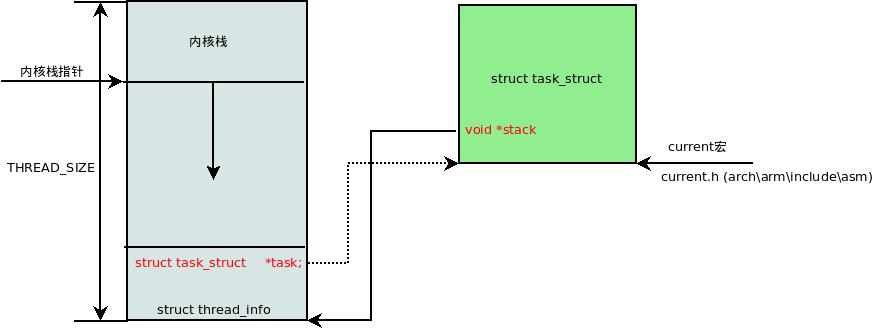
在重游《LDD3》的时候,又发现了一个当年被我忽略的一句话:
“内核具有非常小的栈,它可能只和一个4096字节大小的页那样小”
针对这句话,我简单地学习了一下进程的“内核栈”
什么是进程的“内核栈”?
在每一个进程的生命周期中,必然会通过到系统调用陷入内核。在执行系统调用陷入内核之后,这些内核代码所使用的栈并不是原先用户空间中的栈,而是一个内核空间的栈,这个称作进程的“内核栈”。
比如,有一个简单的字符驱动实现了open方法。在这个驱动挂载后,应用程序对那个驱动所对应的设备节点执行open *** 作,这个应用程序的open其实就通过glib库调用了Linux的open系统调用,执行系统调用陷入内核后,处理器转换为了特权模式(具体的转换机制因构架而异,对于ARM来说普通模式和用户模式的的栈针(SP)是不同的寄存器),此时使用的栈指针就是内核栈指针,他指向内核为每个进程分配的内核栈空间。
内核栈的作用
我个人的理解是:在陷入内核后,系统调用中也是存在函数调用和自动变量,这些都需要栈支持。用户空间的栈显然不安全,需要内核栈的支持。此外,内核栈同时用于保存一些系统调用前的应用层信息(如用户空间栈指针、系统调用参数)。
内核栈与进程结构体的关联
每个进程在创建的时候都会得到一个内核栈空间,内核栈和进程的对应关系是通过2个结构体中的指针成员来完成的:
(1)struct task_struct
在学习Linux进程管理肯定要学的结构体,在内核中代表了一个进程,其中记录的进程的所有状态信息,定义在Sched.h (include\linux)。
其中有一个成员:void *stack;就是指向下面的内核栈结构体的“栈底”。
在系统运行的时候,宏current获得的就是当前进程的struct task_struct结构体。
(2)内核栈结构体union thread_union
union thread_union {
struct thread_info thread_info;
unsigned long stack[THREAD_SIZE/sizeof(long)];
};
其中struct thread_info是记录部分进程信息的结构体,其中包括了进程上下文信息:
/*
* low level task data that entry.S needs immediate access to.
* __switch_to() assumes cpu_context follows immediately after cpu_domain.
*/
struct thread_info {
unsigned long flags; /* low level flags */
int preempt_count; /* 0 => preemptable, <0 => bug */
mm_segment_t addr_limit; /* address limit */
struct task_struct *task; /* main task structure */
struct exec_domain *exec_domain; /* execuTIon domain */
__u32 cpu; /* cpu */
__u32 cpu_domain; /* cpu domain */
struct cpu_context_save cpu_context; /* cpu context */
__u32 syscall; /* syscall number */
__u8 used_cp[16]; /* thread used copro */
unsigned long tp_value;
struct crunch_state crunchstate;
union fp_state fpstate __attribute__((aligned(8)));
union vfp_state vfpstate;
#ifdef CONFIG_ARM_THUMBEE
unsigned long thumbee_state; /* ThumbEE Handler Base register */
#endif
struct restart_block restart_block;
};
关键是其中的task成员,指向的是所创建的进程的struct task_struct结构体
而其中的stack成员就是内核栈。从这里可以看出内核栈空间和 thread_info是共用一块空间的。如果内核栈溢出, thread_info就会被摧毁,系统崩溃了~~~
内核栈---struct thread_info----struct task_struct三者的关系入下图:

内核栈的产生
在进程被创建的时候,fork族的系统调用中会分别为内核栈和struct task_struct分配空间,调用过程是:
fork族的系统调用--->do_fork--->copy_process--->dup_task_struct
在dup_task_struct函数中:
staTIc struct task_struct *dup_task_struct(struct task_struct *orig)
{
struct task_struct *tsk;
struct thread_info *TI;
unsigned long *stackend;
int err;
prepare_to_copy(orig);
tsk = alloc_task_struct();
if (!tsk)
return NULL;
TI = alloc_thread_info(tsk);
if (!ti) {
free_task_struct(tsk);
return NULL;
}
err = arch_dup_task_struct(tsk, orig);
if (err)
goto out;
tsk->stack = ti;
err = prop_local_init_single(&tsk->dirties);
if (err)
goto out;
setup_thread_stack(tsk, orig);
......
其中alloc_task_struct使用内核的slab分配器去为所要创建的进程分配struct task_struct的空间
而alloc_thread_info使用内核的伙伴系统去为所要创建的进程分配内核栈(union thread_union )空间
注意:
后面的tsk->stack = ti;语句,这就是关联了struct task_struct和内核栈
而在setup_thread_stack(tsk, orig);中,关联了内核栈和struct task_struct:
static inline void setup_thread_stack(struct task_struct *p, struct task_struct *org)
{
*task_thread_info(p) = *task_thread_info(org);
task_thread_info(p)->task = p;
}
内核栈的大小
由于是每一个进程都分配一个内核栈空间,所以不可能分配很大。这个大小是构架相关的,一般以页为单位。其实也就是上面我们看到的THREAD_SIZE,这个值一般为4K或者8K。对于ARM构架,这个定义在Thread_info.h (arch\arm\include\asm),
#define THREAD_SIZE_ORDER 1
#define THREAD_SIZE 8192
#define THREAD_START_SP (THREAD_SIZE - 8)
所以ARM的内核栈是8KB
在(内核)驱动编程时需要注意的问题:
由于栈空间的限制,在编写的驱动(特别是被系统调用使用的底层函数)中要注意避免对栈空间消耗较大的代码,比如递归算法、局部自动变量定义的大小等等
欢迎分享,转载请注明来源:内存溢出

 微信扫一扫
微信扫一扫
 支付宝扫一扫
支付宝扫一扫
评论列表(0条)